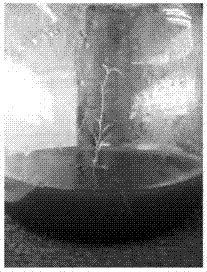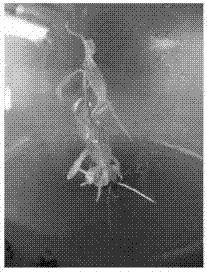Rooting method for un-rooted tissue culture seedlings of salix matsudana var.tortuosa
A technology for tissue culture of seedlings and willow willows is applied in the field of forest tree cultivation, which can solve the problems of large cost and energy consumption, reduce the cultivation environment, complicated operation, etc., and achieve the effects of strong repeatability, abundant explants, and stable cultivation conditions.
- Summary
- Abstract
- Description
- Claims
- Application Information
AI Technical Summary
Problems solved by technology
Method used
Image
Examples
Embodiment 1
[0126] 1. Preparation of Media
[0127] (1) Adjust the pH of the MS medium to 5.8 with NaOH, add 6.5g of agar powder, sterilize at 121°C for 20 minutes, and cool to 50°C for use; Naphthaleneacetic acid and 6-benzylaminoadenine, use the aperture Sterilize by filtration through a 0.22 μm filter membrane; add 1 g of activated carbon, 0.15 mg of sterilized naphthaleneacetic acid, and 1 mg of 6-benzylaminoadenine to the agar-MS prepared in the above steps, dilute to 1 L, and solidify to complete the preparation.
[0128] 2. Tissue culture process
[0129] Such as figure 1 As shown, the morphological lower end of the unrooted tissue-cultured seedlings of Salix lanceolata was inserted into the medium, and one branch of Salix lanceolata was inoculated in each medium, and placed in a tissue culture room at a temperature of 27°C, light of 3000 lx, and 10 hours of light 100 unrooted tissue cultured seedlings were co-cultivated under this culture condition.
[0130] 3. Tissue culture r...
Embodiment 2
[0133] 1. The preparation of the medium is the same as in Example 1 with the tissue culture process, the difference is only the weight of adding gac, naphthaleneacetic acid and 6-benzylaminoadenine when preparing the medium:
[0134] Activated carbon 2.5g, naphthaleneacetic acid 0.4mg, 6-benzylaminoadenine 0.8mg.
[0135] 2. Tissue Culture Results
[0136] The unrooted tissue-cultured seedlings of Salix japonica just begin to take root after 14 days; the rooting rate is 90%;
Embodiment 3
[0138] 1. The preparation of the medium is the same as in Example 1 with the tissue culture process, the difference is only the weight of adding gac, naphthaleneacetic acid and 6-benzylaminoadenine when preparing the medium:
[0139] Activated carbon 0.75g, naphthaleneacetic acid 0.08mg, 6-benzylaminoadenine 0.5mg.
[0140] 2. Tissue Culture Results
[0141] The unrooted tissue-cultured seedlings of Salix japonica just begin to take root after 14 days; the rooting rate is 90%;
PUM
| Property | Measurement | Unit |
|---|---|---|
| Membrane pore size | aaaaa | aaaaa |
Abstract
Description
Claims
Application Information
 Login to View More
Login to View More - R&D
- Intellectual Property
- Life Sciences
- Materials
- Tech Scout
- Unparalleled Data Quality
- Higher Quality Content
- 60% Fewer Hallucinations
Browse by: Latest US Patents, China's latest patents, Technical Efficacy Thesaurus, Application Domain, Technology Topic, Popular Technical Reports.
© 2025 PatSnap. All rights reserved.Legal|Privacy policy|Modern Slavery Act Transparency Statement|Sitemap|About US| Contact US: help@patsnap.com



